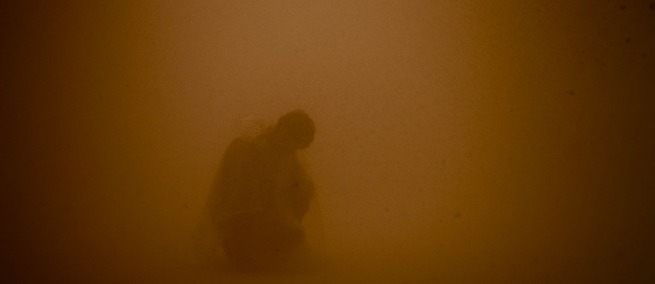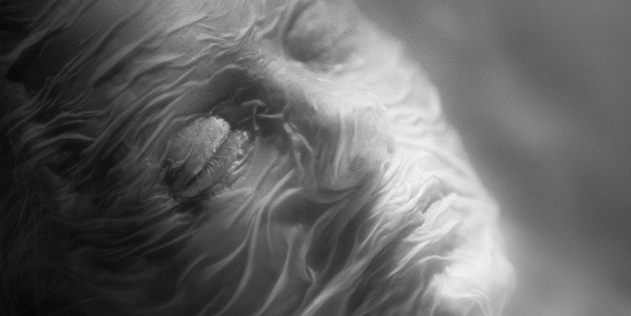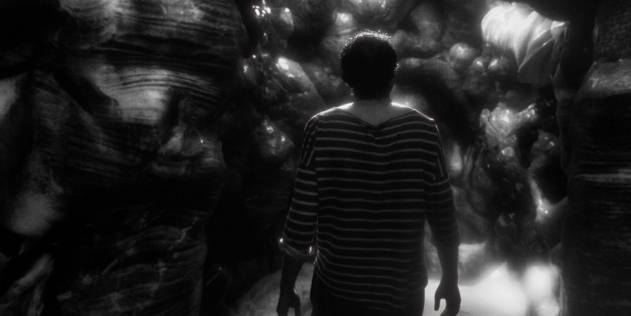
Writer and director Thibault Emin’s feature debut ELSE follows two lovers forced into lockdown together as a new virus causes people’s bodies to merge with the materials that surround them. The film had its world premiere at the Toronto International Film Festival in the “Midnight Madness” section for horror films. We spoke with Emin about the film’s depiction of a virus, his inspirations, and the impact of the real COVID pandemic on the story.
Science & Film: Sound is very present in the film from the beginning—you hear the squelching of the fig, he's watching an ASMR channel... How did you think about sound in relation to the theme of the film, which is so visual?
Thibault Emin: Sound is so much about the feeling. My goal with sound was really to get into something immersive, but it concerns mostly the second part of the film, more than the first. My favorite films with sound are BLADE RUNNER and David Lynch's ERASERHEAD. Movies that have this immersive quality through sound—that was my conscious goal with the sound designer. It's what I like in the ambient music too; abolishing the border between sound and music, which I guess is related to the story, what the movie is about.

Courtesy of TIFF
S&F: Could you speak to your inspiration for this virus?
TE: The inspiration was, well, of course, David Cronenberg's films that are really important to me and also Mood Indigo, the Boris Vian novel that I read when I was young. This way of making emotions turn into real stuff happening in the movie's reality, I think it's really about this. This is common to some of Cronenberg's films and their surrealistic logic. These are important inspirations.
I'm a very abstract person. I studied philosophy before cinema and so everything came from ideas in this project. What was first there was the ending, this idea of everything merging together. I don't want to say too much... So, the whole question was how to eventually get there. And that's where the virus came from. For me, we're not even sure that it is a virus in the film. But the virus is, for me, the starting point, because it's the most obvious and it's what we all fear. When something is new, we always think of a virus, and it's become more obvious with COVID. But actually, the film was written even before, and COVID was confirming something that was already there. The virus is, for me, the illusion of fear that we can feel in front of something unknown. Viruses, as Cronenberg would say, are not always a threat. They can also be maybe a life form. Maybe life is a virus at the beginning.
S&F: I was going to ask probably the obvious question, which is how the pandemic that we are all familiar with impacted your development of this story, and it's interesting to hear that you were working on it beforehand.
TE: Yes. Actually, I was quite disappointed when COVID came, because it ruined by my story. Especially the idea of lockdown. I mean, I really wrote a whole part of the film about a lockdown before the actual lockdown. What was the point, when it became real and so familiar to all of us? But I hope that's a way that the audience can relate, maybe better now, to the film.
S&F: Despite the conceptual nature of the premise, you integrate some scientific videos throughout the film. Did you consult with any scientists during the writing or filmmaking process?
TE: No, I did not consult except for one thing. The story of the deepness—I'm not sure how to say it in English, the first fish that could breathe out of water that is told later in the film. This is the only pseudo-scientific element that came from a biologist friend who told me about this fish. I'm not into science at all. I'm kind of rather a literary person, so actually, it was a challenge for me and for from my friend who wrote with me, to not be too surrealistic, because I am more thinking in a surrealistic way, and that's what interests me in movies. Scientific realism doesn't really turn me on. I know a lot of people love it, but it's not my relationship with sci-fi and imaginary worlds, I prefer dream-like logic and philosophical intellectual logic or emotional logic. But yes, we gathered a lot of different images and sources of inspiration, and the video of the cells merging together came rather late in the process. One friend told me, you should have this kind of image in the film to show the process. And I said, of course, it's obvious. I've been working on this 10 years, and I never thought of it. That's how it came to be.

Courtesy of TIFF
S&F: There is a lot of humor in the film, which is surprising for its subject matter.
TE: It came through the process of writing, but yes, it was important to me. Actually, the movie was supposed to be a lot funnier in its first part, but a lot of the jokes didn't work, so we just had to cut them. But yes, humor was very, very important to me, and maybe not taking things too seriously. At some point it became a problem in the process of editing, especially because test viewers always told us, well, there are too many jokes, you have to take your own story seriously, otherwise we will never be afraid, we won't believe it. So it took many, many months for me and the editor to say, let's cut a lot of jokes, a lot of fun, because we have to take it seriously. I think it's even not serious enough in the actual movie now maybe. The female character is inspired by a girlfriend of mine, my first great love story when I was 20 years old, and she was a little bit like that.
♦
TOPICS